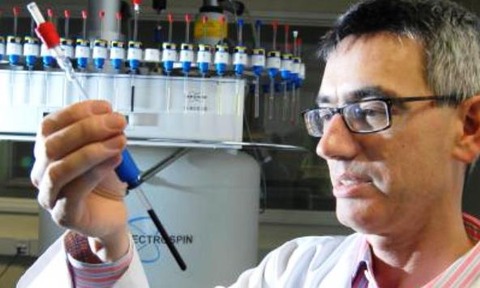Artificial molecules combat cancer
4 Aug 2014

Scientists have created self-assembling anti-cancer molecules that mimic the body’s cancer fighting defence mechanisms, new research suggests.
Researchers at the University of Warwick have developed anti-cancer molecules that have a similar structure to peptides which are naturally produced in the body to fight various forms of cancer and infection.
The study has been published in the journal Nature Chemistry.
Produced in collaboration with Roger Phillips at the Institute for Cancer Therapeutics, the researchers at Warwick claim the synthetic molecules have proved effective against colon cancer cells in laboratory tests.
“The chemistry involved is like throwing Lego blocks into a bag…and finding that you made a model of the Death Star
Prof Peter Scott
Lead researcher Peter Scott told LaboratoryTalk that of all the cancer cell lines tested, the compounds were unusually active against colon cancer cells.
“The concentration needed was at less than micromolar,” Scott said.
Artificial peptides like those created at Warwick, had previously been difficult and expensive to manufacture in large quantities, the researchers say.
Now, however, scientists have perfected the technique - dramatically reducing the overall time and cost of the process.
“The chemistry involved is like throwing Lego blocks into a bag, giving them a shake, and finding that you made a model of the Death Star,” said Scott.
“The design to achieve that takes some thought and computing power, but once you’ve worked it out the method can be used to make a lot of complicated molecular objects.”
Explaining how the process of self-assembly works, Scott said: “When the organic chemicals involved are mixed with iron chloride in a solvent, such as water or methanol, they form strong bonds and are designed to naturally fold together in minutes to form a helix. It’s all thermodynamically downhill. The assembly instructions are encoded in the chemicals themselves.”
According to Scott, once the solvent has been removed we are left with the peptide mimics in the form of crystals.
“There are no complicated separations to do, and unlike a Lego model kit there are no mysterious bits left over. In practical terms, the chemistry is pretty conventional. The beauty is that these big molecules assemble themselves,” said Scott.
“Nature uses this kind of self-assembly to make complex asymmetric molecules like proteins all the time, but doing it artificially is a major challenge.”
Though still in its infancy, the research is promising, especially considering the peptides’ low toxicity to bacteria which Scott described as “very unusual”.
“The next step is to find out in more detail how the [peptides] work, which we will do with our co-authors at the Institute for Cancer Therapeutics. Also, while we already know they have low toxicity to bacteria and they are made of quite friendly components, we need to determine how well they select for cancer cells against healthy human cells,” Scott said.
Once further research has been conducted, Scott and his team can look at performing clinical trials on patients.

